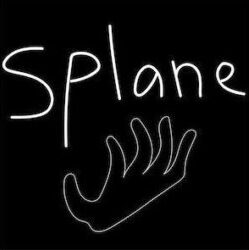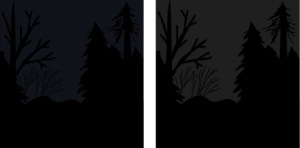Reflections on Light in the Dark

I took a walk late yesterday evening with my dog. By the time we were on our way home, it was quite dark, moving beyond dusk into night. I had the opportunity to witness some of the qualities of light when it’s dark.
Although the sky was overcast, solid Northwest gray all day long, in the diminishing light the sky turned a deep, deep blue, contrasted with the darker shadows. Compare these two quick sketches:
The one on the left has a deep blue for the sky (behind a black screen with medium transparency). The one on the right has only the black transparency. The one on the right gives the impression of artificial light, perhaps coming from a distant city.
On a small rise in a meadow I’ve walked through hundreds of times, in the dark I could see a thin line, a demarcation between the higher level and the beginning of the slope. The line is completely invisible in the light. But something about the quality of light in the dark made this convergence zone of sorts pop out:
One time I walked through a forest in the dark. At first I tried to see, stretching out my hands and groping, taking halting little steps. It was useless. My progress was so slow I believed I would never make it out. So I gave up on sight and closed my eyes. Within a minute or so, I could hear the trees, and I walked through the entire forest, eyes closed, hearing my way through the trees, arms at my sides, fairly confident. Last night I thought about how in a drawing you might capture this sound quality of trees (or of myself in interaction with the trees) in a dark forest. I immediately thought of Van Gogh of course and his shimmering objects, emanating energy.
Look at his olive trees and how they move. That’s what I found in the dark that night.
Featured image is Vincent Van Gogh’s “Olive Grove,” 1889.


